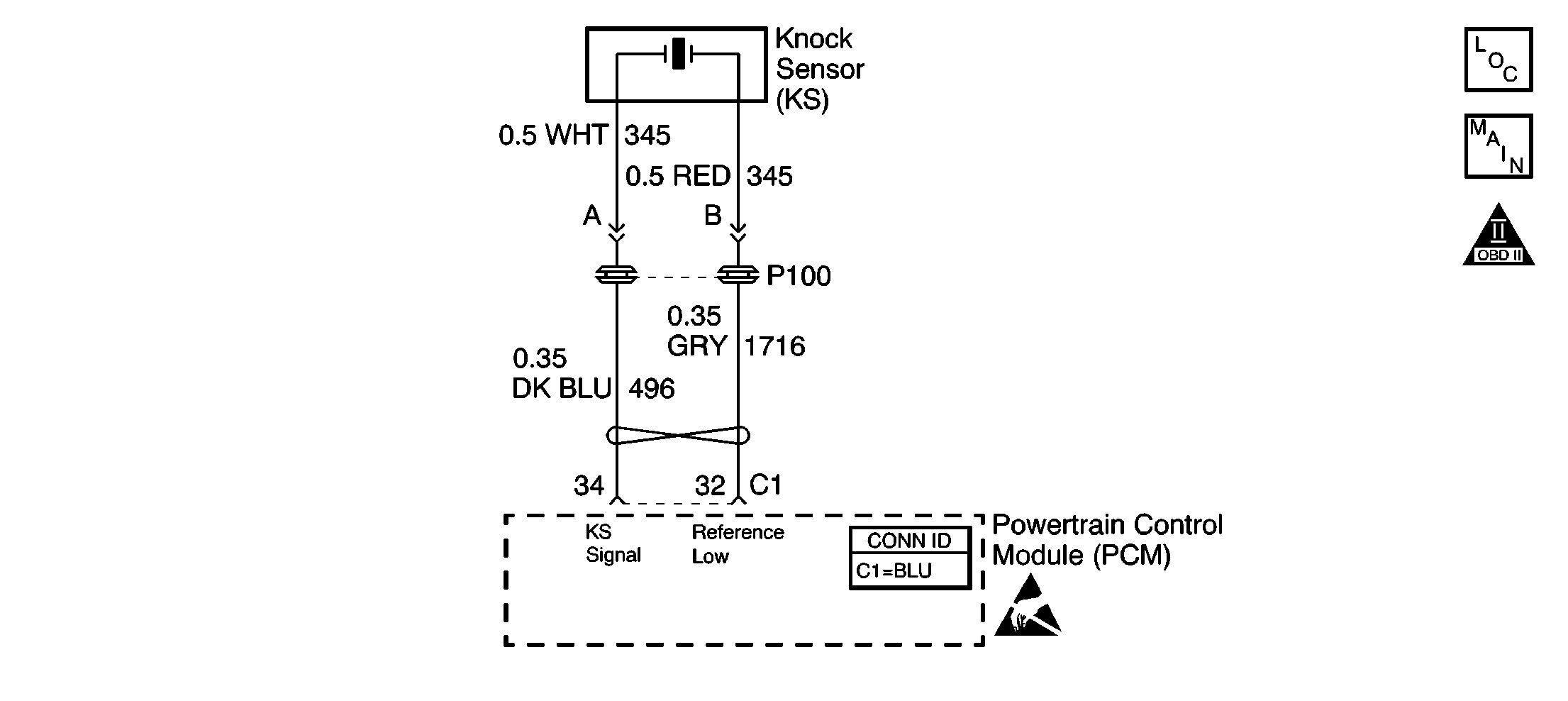
Circuit Description
The knock sensor (KS) system detects for an engine detonation. The KS produces an AC voltage signal. The amplitude and the frequency of the AC voltage signal is dependent upon the knock level being detected. If knock is detected, the PCM will retard the spark timing based on the signal from the KS.
Conditions for Running the DTC
| • | The engine run time is more than 20 seconds. |
| • | The engine coolant temperature (ECT) is more than 70°C (158°F). |
| • | The engine speed is between 1800-2400 RPM. |
| • | The manifold absolute pressure (MAP) is more than 35 kPa. |
| • | The engine vacuum is between 33-45 kPa. |
Conditions for Setting the DTC
| • | The KS voltage and variation is not within the normally expected ranges. |
| • | The above conditions are present for more than 15 seconds. |
Action Taken When the DTC Sets
| • | The malfunction indicator lamp (MIL) will illuminate after 2 consecutive ignition cycles in which the diagnostic runs with the fault active. |
| • | The PCM records the operating conditions at the time when the diagnostic fails. This information stores in the Freeze Frame and Failure Records buffers. |
| • | A history DTC stores. |
| • | The coolant fan turns on. |
Conditions for Clearing the DTC
| • | The MIL will turn off after 3 consecutive ignition cycles in which the diagnostic runs without a fault. |
| • | A history DTC will clear after 40 consecutive warm up cycles without a fault. |
| • | The DTC can be cleared by using the scan tool. |
Diagnostic Aids
| • | Correct any abnormal engine noise before using the diagnostic table. |
| • | Thoroughly inspect any suspected circuitry for the following conditions: |
| - | Any backed out terminals |
| - | Any incorrect mating |
| - | Any broken locks |
| - | Any incorrectly formed connectors |
| - | Any damaged terminals |
| - | Any poor terminal-to-wiring connections |
| - | Any physical damage to the wiring harness |
| • | Test the KS for the proper torque. |
| • | Inspect the KS mounting location between the sensor and the engine mounting face for the following conditions: |
| - | Any burrs |
| - | Any casting flash |
| - | Any other foreign material |
| • | Verify that the KS head is clear of contact with any of the following items: |
| - | The hoses |
| - | The brackets |
| - | The engine electrical wiring |
| • | Inspect the KS wiring for the correct twisting of the wiring. The wiring for should have a minimum of 9 twists per foot. This twisting of the wiring reduces electrical noise on the KS circuit, lessening the chance of erratic signals to the PCM. |
Test Description
The numbers below refer to step numbers on the diagnostic table.
-
If the engine has an internal knock or an audible noise that causes a knocking type noise on the engine block, the knock sensor may be responding to the noise.
-
This step tests the internal resistance of the PCM and the wiring to the knock sensor connector.
-
The replacement PCM must be programmed and the Crankshaft Position System Variation Learn procedure must be performed.
Step | Action | Values | Yes | No | ||||||
|---|---|---|---|---|---|---|---|---|---|---|
1 | Did you perform the Powertrain On-Board Diagnostic (OBD) System Check? | -- | Go to Step 2 | |||||||
Can a knock or a noise be heard? | -- | Go to Step 3 | Go to Step 4 | |||||||
3 |
Did you find and correct the condition? | -- | Go to Step 12 | Go to Diagnostic Aids | ||||||
4 |
Does the test lamp illuminate? | -- | Go to Step 5 | Go to Step 6 | ||||||
Is the resistance within the specified range? | 95K -105K ohms | Go to Step 9 | Go to Step 7 | |||||||
6 |
Did you find and correct the condition? | -- | Go to Step 12 | Go to Step 8 | ||||||
7 |
Did you find and correct the condition? | -- | Go to Step 12 | Go to Step 8 | ||||||
8 |
Did you find and correct the condition? | -- | Go to Step 12 | Go to Step 11 | ||||||
9 |
Did you find and correct the condition? | -- | Go to Step 12 | Go to Step 10 | ||||||
10 | Replace the knock sensor. Refer to Knock Sensor Replacement . Did you complete the repair? | -- | Go to Step 12 | -- | ||||||
|
Important:: The replacement PCM must be programmed. Refer to Powertrain Control Module Replacement/Programming . Replace the PCM. Refer to Powertrain Control Module Replacement . Did you complete the replacement? | -- | Go to Step 12 | -- | |||||||
12 |
Does the DTC reset? | -- | Go to Step 3 | System OK |
